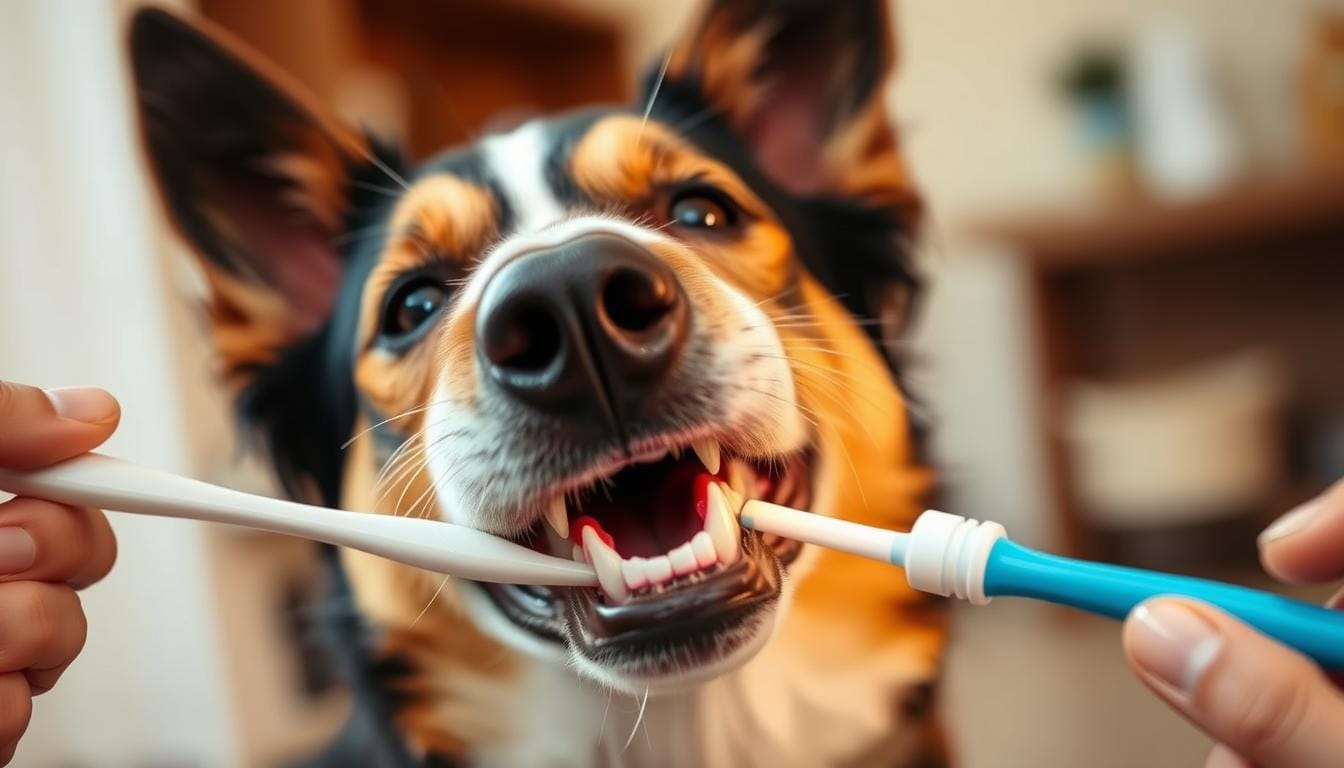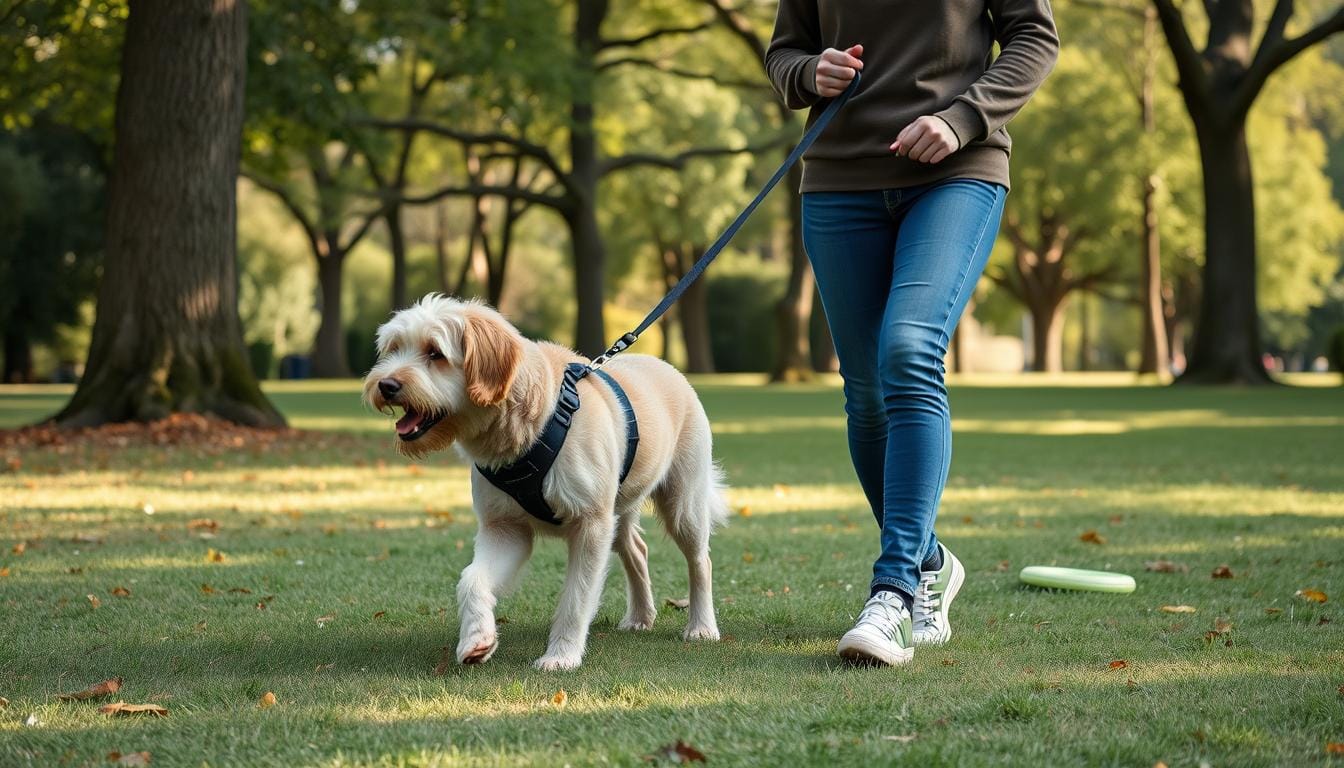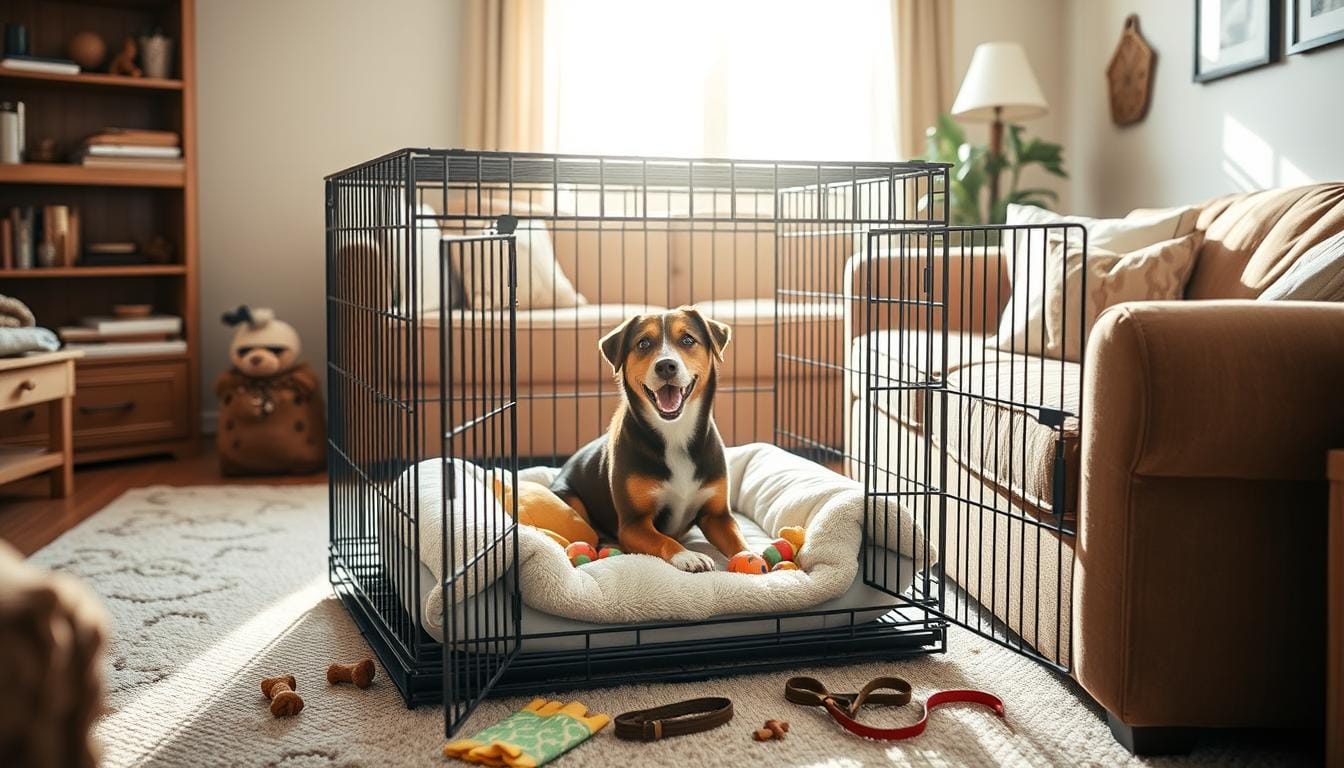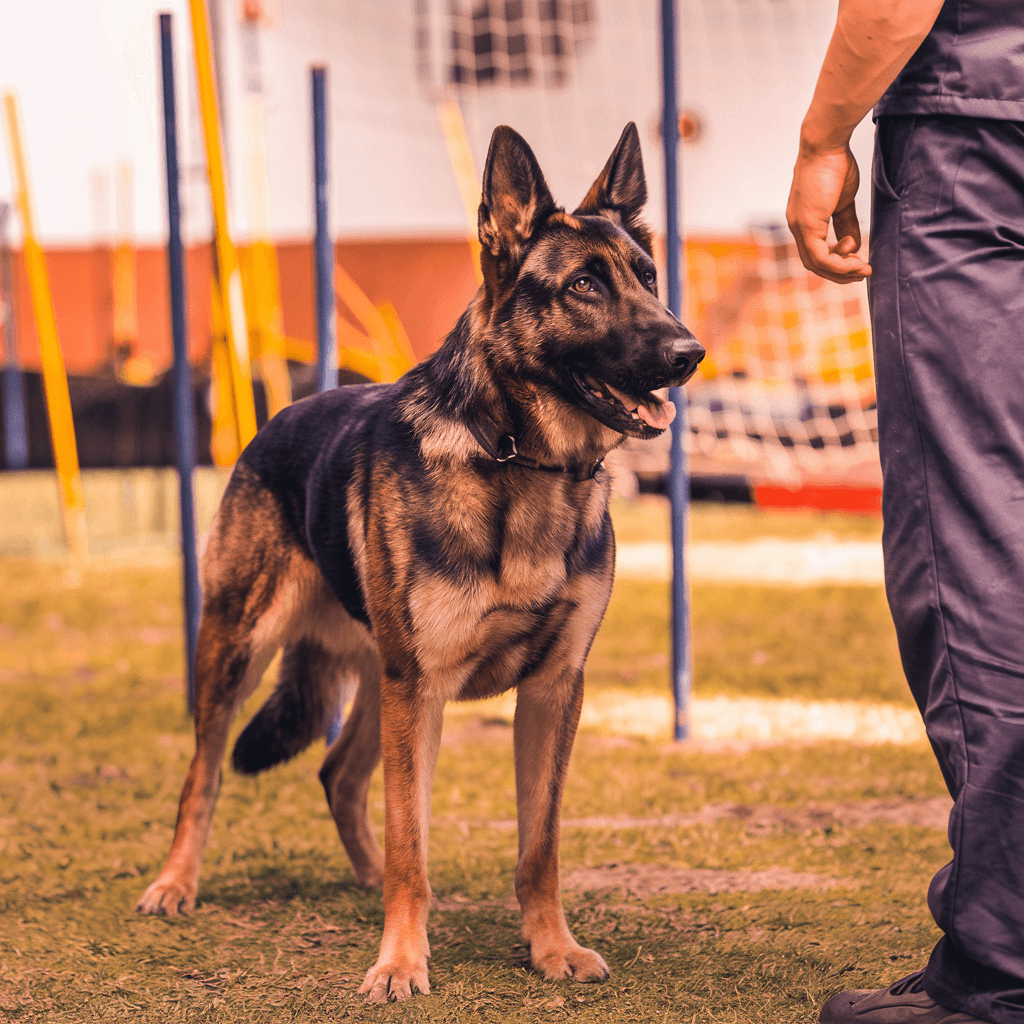We all want our furry friends to have healthy teeth and fresh breath. Dog dental care is a crucial part of pet ownership that’s often overlooked. By age three, most dogs show signs of periodontal disease, according to the American Veterinary Dental College. This condition can lead to serious health issues if left untreated.
Brushing dog teeth regularly is key to maintaining their oral health. It’s not just about preventing bad breath; it’s about ensuring your dog’s overall well-being. Poor dental hygiene can result in tooth loss, painful abscesses, and even heart disease in severe cases.
Luckily, there are many ways to keep your dog’s teeth clean and healthy. From daily brushing to professional cleanings, we’ll explore essential tips for dog hygiene that will help maintain your pup’s pearly whites. With the right approach, you can make dental care a positive experience for both you and your dog.
Key Takeaways
- Regular dental care is essential for dogs’ overall health
- Most dogs show signs of periodontal disease by age three
- Daily tooth brushing is crucial for maintaining dog dental hygiene
- Professional cleanings are recommended for thorough oral care
- Poor dental health can lead to serious systemic issues in dogs
- Consistent dental care helps prevent tooth loss and painful conditions
Understanding Canine Dental Health Importance
Keeping your dog’s teeth clean is key to their health. Many of us don’t realize how important dog dental health is. Let’s explore why it’s so crucial for your furry friend.
Statistics on Dog Dental Disease
The numbers show how common dog dental disease is:
- By age 3, most dogs show early signs of dental issues
- Dental disease severity is graded from 0 (normal) to 4 (severe)
- Most dental problems occur below the gumline, hidden from view
Impact of Poor Dental Hygiene
Ignoring your dog’s teeth can cause big problems:
- Pain and discomfort
- Tooth loss
- Potential organ damage if bacteria enter the bloodstream
Regular brushing of your dog’s teeth can prevent these issues and promote better overall health.
Common Signs of Dental Problems
Look out for these signs of dental health issues in dogs:
- Bad breath
- Difficulty eating
- Drooling
- Yellow or brown tartar on teeth
- Swollen gums
- Missing or loose teeth
Spotting these signs early and getting proper care can keep your dog’s teeth healthy. This helps avoid bigger problems later.
Essential Tools for Dog Dental Care
Keeping your furry friend’s teeth clean is crucial for their overall health. We’ve compiled a list of must-have tools for effective dog dental care. Let’s dive into the essentials!

A quality dog toothbrush is the cornerstone of canine oral hygiene. The Virbac C.E.T. Dual Ended Toothbrush, priced at $7, offers versatility for different tooth sizes. For budget-conscious pet parents, the Pet Republique Dog Toothbrush Pack of 6 costs just $9, providing excellent value.
Pairing your brush with dog toothpaste is vital. Virbac C.E.T. Plaque Tartar-Control Enzymatic Dog Toothpaste, at $12, is a popular choice. For a more affordable option, try Arm & Hammer for Pets Tartar Control Enzymatic Toothpaste at $6. Remember, never use human toothpaste on dogs!
For dogs who resist brushing, dental wipes offer a great alternative. Dechra Vetradent Dental Wipes, priced at $25, are effective for maintaining oral hygiene between brushings. These wipes are especially useful for puppies or older dogs with sensitive mouths.
- Jasper 360º Dog Toothbrush ($17): Ideal for thorough cleaning
- Virbac C.E.T. Enzymatic Oral Hygiene Chews ($25): Great for supplemental care
- ProDen PlaqueOff Powder Dog Supplement ($21): Helps fight plaque buildup
By incorporating these tools into your dog’s dental care routine, you’ll be well-equipped to maintain their oral health and prevent dental issues down the road.
Dog dental care, brushing dog teeth, healthy teeth, dog hygiene
Keeping your dog’s teeth clean is key to their health. With the right tools and methods, you can brush your dog’s teeth well. Here’s what you need for effective dog teeth cleaning.
Selecting the Right Dog Toothbrush
Choose a toothbrush with soft bristles and an angled handle for your dog. This makes it easy to clean their teeth and gums. Finger brushes are also great, as they fit over your finger for better control.
Choosing Dog-Safe Toothpaste
Don’t use human toothpaste on your dog. Instead, pick a toothpaste made just for dogs. It should taste good, like chicken or peanut butter. Enzymatic toothpastes are best, as they break down plaque and freshen breath.
Additional Cleaning Tools
There are more tools to help keep your dog’s mouth clean:
- Dental wipes: Quick and easy to use
- Oral sprays: Fight bacteria and freshen breath
- Dental powders: Sprinkle on food to prevent plaque
- Dental chews: Encourage chewing to clean teeth
Look for the Veterinary Oral Health Council (VOHC) seal on products. It means they’re good at removing plaque and tartar. Using these tools in your dog’s dental care routine is crucial for their health.
Step-by-Step Guide to Brushing Your Dog’s Teeth
Keeping your dog’s teeth clean is key for their health. We’ll show you how to brush your dog’s teeth easily. This way, it won’t stress you or your pet.
Creating a Positive Environment
First, pick a quiet spot for brushing your dog’s teeth. Slowly introduce the toothbrush and toothpaste. Let your dog taste a bit of toothpaste on your finger first.
Proper Brushing Technique
Ready to brush your dog’s teeth? Here’s how:
- Gently lift your dog’s lip to see their teeth and gums.
- Brush in circular motions on the outer teeth surfaces.
- Pay special attention to the gum line where plaque builds up.
- Move around the mouth slowly, praising your dog as you go.

Frequency and Duration
Brush your dog’s teeth at least three times a week. Each session should be about 30 seconds per side. Being consistent is crucial for their dental health.
| Brushing Frequency | Duration | Benefits |
|---|---|---|
| Daily | 2 minutes total | Optimal plaque prevention |
| 3 times/week | 1 minute per side | Effective tartar control |
| 2 times/week | 30 seconds per side | Minimum recommended care |
By following this guide, you’ll create a good dog dental routine. Brushing your dog’s teeth regularly keeps them healthy and strengthens your bond.
Professional Dental Cleaning Services
Professional dental cleaning is key for your dog’s health. At Brooklyn Pet Spa, we do more than just brush teeth. Our team scales teeth, removes plaque, and polishes to keep your pet’s smile bright.
Our dental care sessions start with a detailed check-up. We might take X-rays to check jaw and tooth health. Depending on your dog, we might use anesthesia for a stress-free cleaning.
Frequency of Professional Cleanings
Most dogs need annual dental cleanings. But, age, breed, diet, and health can change this. Some dogs might need more frequent cleanings to avoid dental problems.
“Regular dental cleanings prevent harmful bacteria from entering a dog’s bloodstream and affecting organs.”
We suggest combining professional cleanings with home care. Brushing, dental chews, and a balanced diet are key. Our team teaches you how to brush right and offers dental care kits for home.
| Service | Description | Frequency |
|---|---|---|
| Professional Cleaning | Thorough cleaning, scaling, and polishing | Annually or as needed |
| Dental Check-up | Examination and early problem detection | Every 6 months |
| Educational Workshop | Learn about canine dental health and care | Monthly |
Investing in professional dental care is good for your dog’s health. Regular cleanings prevent big problems and keep your pet’s smile healthy and happy for a long time.
Natural Methods for Dental Hygiene
Keeping your dog’s teeth clean can be tough. We’re excited to share natural ways to make it easier and fun for you and your dog.
Dental Chews and Treats
Dog dental chews are great for oral health. They remove plaque and tartar as your dog chews. For example, Gnashers Daily Dental Chews have pumpkin seeds and coconut oil. These ingredients clean teeth and freshen breath.
Beneficial Food Choices
Some foods can clean your dog’s teeth naturally. Carrots, for example, make saliva that washes away bacteria. Crunchy kibble also helps remove plaque. Adding a bit of cinnamon to their food can prevent tooth decay and freshen breath. But, use cinnamon carefully as too much can harm.
Natural Dental Aids
Raw meaty bones are good for dental health, but watch your dog. Avoid pork, chicken, or fish bones. Deer antlers are safer. Natural dental sprays with grapefruit seed extract or coconut oil can kill plaque and freshen breath. Coconut oil is also a good toothpaste alternative, as it may reduce gingivitis.
- Up to 80% of dogs suffer from gum and tooth issues
- Dental chews are a favored natural tooth brushing option
- Coconut oil contains acids that can remove bacteria in a dog’s mouth
- Monitoring a dog’s diet is vital for maintaining dental hygiene
Using these natural methods in your dog’s dental care can keep their teeth clean and breath fresh. Always talk to your vet before trying new dental products or methods.
Preventing Plaque and Tartar Buildup
Dog plaque prevention starts with understanding the process. Plaque forms on a dog’s teeth within hours after eating. It hardens into tartar within 24 hours. This buildup can lead to serious health issues if left unchecked.
Effective tartar control for dogs involves daily tooth brushing. It’s the gold standard in canine dental care. Use a dog-specific toothbrush and toothpaste, focusing on the outer surfaces of the teeth where tartar tends to accumulate. Even brushing once a week can make a difference.
Dental chews and toys designed for plaque removal can supplement your brushing routine. These items help scrape away plaque before it hardens. Water additives can also reduce bacterial count in your dog’s mouth, improving breath and overall oral health.
| Dental Care Method | Frequency | Effectiveness |
|---|---|---|
| Tooth Brushing | Daily | High |
| Dental Chews | 2-3 times per week | Medium |
| Water Additives | Daily | Medium |
Professional cleanings by a veterinarian every 6-12 months are crucial for maintaining optimal dental health. These cleanings can remove stubborn tartar and catch any developing issues early. Remember, good canine dental care not only prevents bad breath but also protects your dog’s overall health.
Managing Bad Breath in Dogs
Bad breath in dogs, known as dog halitosis, is a common concern for pet owners. We’ll explore the causes, treatments, and prevention strategies for canine oral odor. This will help you keep your furry friend’s breath fresh.
Common Causes
Poor oral hygiene is the main cause of dog halitosis. Plaque and tartar buildup can lead to gum disease and tooth decay. This results in unpleasant odors. Some breeds, like Greyhounds and small dogs, are more prone to dental issues.
Diet and underlying health conditions can also contribute to bad breath.
Treatment Options
Regular teeth brushing is key to maintaining fresh dog breath. Brush 2-3 times a week, or daily if you can. Dental chews and toys can also help by scraping off plaque.
For persistent issues, professional cleanings under anesthesia may be needed.
- Use dog-specific toothbrushes and pet-safe toothpaste
- Provide dental chews with the Veterinary Oral Health Council’s Seal of Acceptance
- Consider water additives and dental supplements
- Consult a vet for prescription dental foods
Prevention Strategies
Preventing canine oral odor starts with a consistent dental care routine. Include dental-friendly foods and regular check-ups to keep your dog’s oral health in check. Watch for unusual eating habits and seek vet care if bad breath persists.
This could signal underlying health issues like kidney disease or diabetes.
| Prevention Method | Frequency | Benefits |
|---|---|---|
| Teeth Brushing | 2-3 times weekly | Reduces plaque and tartar buildup |
| Dental Chews | Daily | Cleans teeth and freshens breath |
| Vet Check-ups | Annually | Early detection of dental issues |
| Balanced Diet | Ongoing | Promotes overall oral health |
Dental Health for Different Dog Ages
Dogs’ dental needs change as they grow. We’ll explore how to care for your furry friend’s teeth at every life stage, from puppy to senior.
Puppy dental care is crucial for establishing good habits. Introduce gentle teeth brushing early and provide appropriate chew toys. This sets the foundation for a lifetime of healthy teeth.
Adult dog dental health requires regular maintenance. Brush their teeth daily, offer dental chews, and schedule annual professional cleanings. These steps prevent plaque buildup and keep their breath fresh.
Senior dog teeth need extra attention. As dogs age, they become more prone to dental issues. Increase the frequency of professional cleanings and use softer brushing techniques to accommodate potential tooth sensitivity.
“Fresh-smelling breath in dogs is a sign of healthy teeth.”
Remember, small breeds and flat-faced dogs are more susceptible to dental problems. Adjust your care routine accordingly and consult your vet for personalized advice.
| Age Group | Dental Care Focus | Frequency of Professional Cleaning |
|---|---|---|
| Puppy | Gentle introduction to brushing | As recommended by vet |
| Adult | Regular brushing and dental chews | Annually |
| Senior | Gentle brushing and nutrient-rich food | Twice yearly or as needed |
By tailoring your approach to your dog’s age, you’ll ensure a lifetime of healthy smiles and wagging tails.
Signs of Dental Emergency
As pet owners, we must watch our furry friends’ dental health closely. Knowing the signs of dog dental emergencies is key. Look out for excessive drooling, bleeding gums, or trouble eating. If you see these signs, act fast.
Immediate Action Steps
If you think your dog has a tooth injury, stay calm. Gently check their mouth if they let you. But don’t push if they’re in pain. Your quick action can help a lot in dental emergencies.
When to Contact a Veterinarian
Call your vet if you see any dental trouble signs. Broken teeth, bad breath, or loose teeth need vet help right away. Keep your vet’s emergency number handy and know where the nearest animal hospital is.
Emergency Prevention
Preventing dental emergencies is important. Start a dental care routine with daily brushing and vet visits. Avoid hard objects for your dog to chew to prevent tooth breaks. Good oral care and regular vet visits keep your dog’s teeth healthy.
















